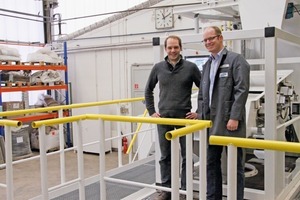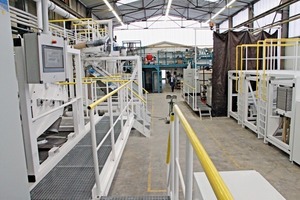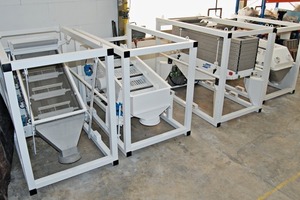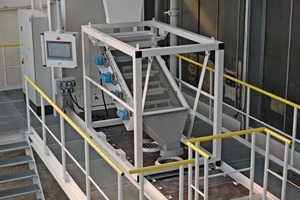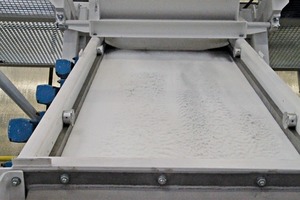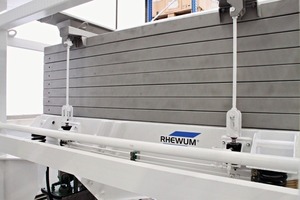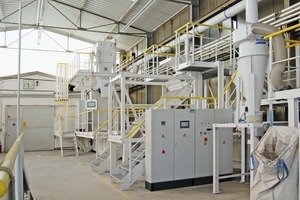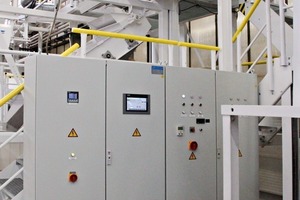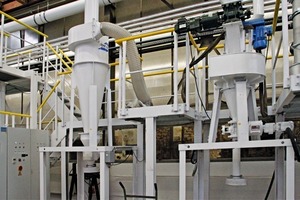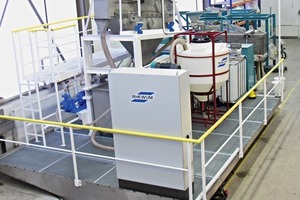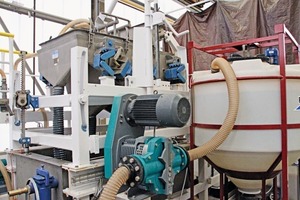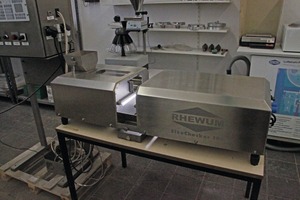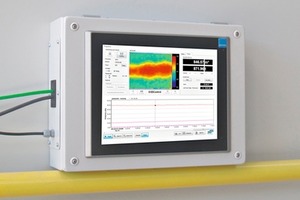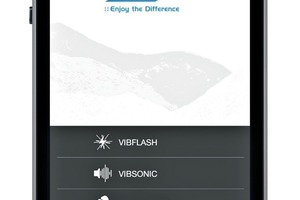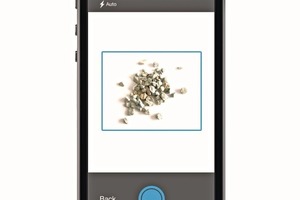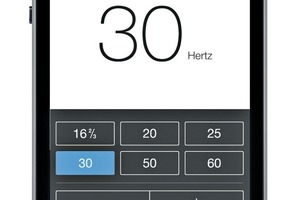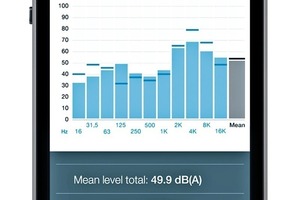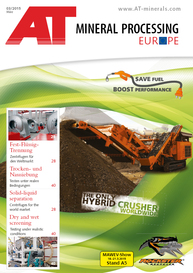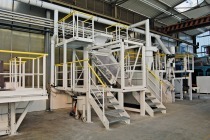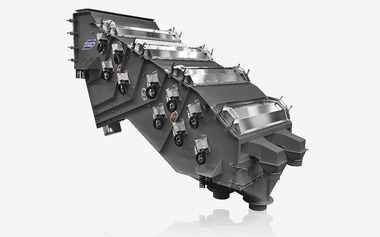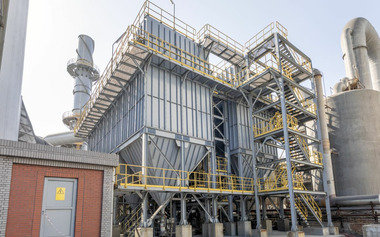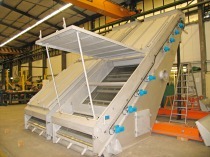Testing under realistic conditions
“Only continuous further development of solution-providing products makes it possible to assure genuine added value for the customer”, affirms Sigurd Schuetz, discussing one of the essential points of the company’s corporate strategy. “Individually evolved solutions and high quality standards - this is the path selected by RHEWUM for the purpose of maintaining long-term and mutually beneficial customer relations”, Schuetz adds.
RHEWUM GmbH was founded as the “Rheinische Werkzeug und Maschinenfabrik” in Remscheid, in Germany’s hilly “Bergisches Land” region, in 1927. The first screening machine, a magnetic screen, left the plant in 1950. Today - after the completion of a further 6000 mechanical screens - family-owned RHEWUM GmbH describes itself as a specialized company: customised mechanical screens have now been joined by other handling equipment for the separation technology, such as sorting machines, particle-size analysers and flow sensors. These systems are used around the globe in the mineral resources and foodstuffs industries, e.g. for the sieving of sugar in the potash and salt sector, for the production of fertilisers, for screening of ores, slags and clinkers, in the animal-feeds industry and in the wide application range of the recycling sector.
The potential applications are highly diversified, and customers come over and over again with new challenges. In order to be able to study and solve such assignments, RHEWUM began in 2012 with the design and construction of a new technology center which would, in particular, make it possible to perform dry- and wet-screening tests under authentic conditions. The test-facilities were ready for use in the autumn of 2014. Her curiosity aroused, Dr. Petra Strunk, Editor-in-Chief at AT MINERAL PROCESSING, visited the new technology center and also took the opportunity of speaking to its manager, Dr.-Ing. Oliver Pikhard.
AT: A new technology center – was there anything to build on, a similar, already existing facility?
Dr. Pikhard: Yes, of course, RHEWUM has had a technology center throughout its existence, for more than 60 years, in other words. The existing building was used for the new technology center, but the interior and the test facilities are all new.
AT: How should our readers imagine such a construction project – it will, without doubt, also present an organisational challenge?
Dr. Pikhard: The building as such already existed, but the entire structural steelwork had to be installed new. The fitting-out of the technology center took two years in total. A lot of things were done in parallel, and we were able to start using the new technology center in the autumn of 2014.
AT: When – and why? – did RHEWUM begin considering expansion of the technology center and the modernisation of its interior equipment?
Dr. Pikhard: The background to the building of the new technology center were RHEWUM’s plans for the development of entirely new products. In the future our technology center will also allow us to expand our product range.
In former times we used to produce mainly ultra-fine mesh screens for dry materials, and the test facilities were all focused on these products. Over the last few years, we have noted that wet-screening also opens up a large range of operations, potential applications, however. But you need the ability to test the material in advance, in order to be able to offer products for this sector, too. This is why we constructed the wet-screening test system, which was installed under an AiF public funding project - a ZIM cooperation project conducted in cooperation with the RWTH Aachen University.
AT: What other test systems have been incorporated into the technology center?
Dr. Pikhard: We built the classifier testing facility because we ourselves intend to further develop and market classifiers. We can only do this if we have our own test facility. As a precondition, the available space had to be reorganized. For this reason, we developed screen modules which can be interchanged and space-savingly stacked. Thereby we only need two test systems for all our dry-screening machines. One test system is for batch tests, and the other for continuous tests, in which the material can be recirculated through the screen module. The two dry-screening test installations enable us to cover all applications.
The wet-screening facility has a modular structure, too. This reflects the RHEWUM GmbH concept, and it means that various screen types and screening parameters, such as the screen mesh and screen size, can be changed quickly to suit the customer’s feed material, for example.
AT: Do students also come to the technology center to perform tests?
Dr. Pikhard: Yes, of course! We publicise this service at various universities, and students from Berlin, Freiberg, Clausthal and Aachen have visited us up to now. It is not only interesting for the students to work in our technology center, we also have a genuine benefit from it. The students are given a clearly defined assignment that they can work on independently, which is, of course, exciting for them as well.
One challenge, here in Remscheid, is the fact that it is a bit out of the way, and it is therefore not always easy to find suitable staff. Our work with these students means that initial contacts can be made, and that the students might come back later. Also new is the opportunity of taking a dual course, with extracurricular training at RHEWUM. We are currently assisting a student from the Hochschule Niederrhein University of Applied Sciences, who is undergoing training as a structural mechanic at RHEWUM in parallel to his Bachelor’s course in “general process-engineering”.
AT: Are there any interesting projects you could mention, by way of example, for which the preliminary research work was performed here in the technology center?
Dr. Pikhard: We have implemented one particularly interesting project for a customer in Thailand. The assignment was to produce six products: the limestone supplied was classified into six fractions at a rate of 150 t/h per screen, and used on site as a building material. The customer sent us big bags containing various particle-size distributions. The tests went extremely well. Thanks to these positive screening tests, eight screening machines were later installed in each plant, I was there for the commissioning, and tested the machines for correct functioning. The results obtained on-the-spot accorded with the laboratory results extremely well, and we were even able to raise throughput capacity above the planned figure, from 150 to 180 t/h.
We can, of course, only sell our customers machines which are suitable for their processes, and that operate to their satisfaction. That’s why we test the feed material here extremely thoroughly, in order to avoid planning errors and the necessity of performing modifications on site.
AT: What can RHEWUM screens really screen? Any and all bulk materials?
Dr. Pikhard: I can tell you straight away of one interesting example! A short while ago a company approached us and wanted to screen glitter in the fine-fraction range. This glitter is used for the production of cosmetics. This production process is extremely complex. It can happen, that in the production of glitter particles the individual glitter particles stick together. Then it is necessary to screen out these so-called “agglomerates”. Additionally the plastic particles also have an extreme tendency to take an electrostatic charge.
The material was extremely expensive - the customer arrived here with a total of 40 kg, and he took his 40 kg with him again when he left! In this particular case we can’t make use of prior knowledge of the material, so we have to perform completely new tests, to gain a “feeling” for the particular material.
AT: Do you also provide services and contract work?
Dr. Pikhard: Not all that often, but in some cases, where the customer is intending to produce a new material. He may have a basic material, and be aiming to provide a range of different products, but does not know yet whether the market will want these products at all. We will then use the customer’s material to produce a range of different fractions, which our customer can use to test his customers’ response. The re-equipping of our technology center now also enables us to test complete processes, such as combinations of screening and classifying processes, for instance.
AT: How far do you take your advisory function in the planning and commissioning of a system?
Dr. Pikhard: Well, it never really stops!
In some cases, we actually go to the plant to find out why machines are not working as expected. This can happen, for example, as a result of product changes, and new applications. In the overwhelming majority of cases, we find the problem and put it right.
AT: So you still get to be on-site, despite being manager of the technology center?
Dr. Pikhard: Oh yes, I’m always there for major installations, and I’ve always liked being on-site anyway. There, I get to see how the machines work on a 1:1 scale - everything working well in the technology center is one thing, but things can sometimes work out totally different on site. Faults can occur because machines are operated completely different than here in the technology center, or because ambient conditions have changed. I always have my sensor hit with me when I’m on site, so that I can isolate the causes of problems as quickly as possible.
AT: As you said before, the technology center is also the incubator for totally new machines and systems. Could you tell our readers about a few examples?
Dr. Pikhard: We already have the SizeChecker, for optical particle-size analysis, the FlowChecker is a new product. It is based on a PMD sensor, which emits light at a special modulated infrared-range wavelength. This light is then reflected and captured by a camera. The light is emitted in pulses, and the precise time it needs to travel to the object and back can thus be determined. I can install this sensor above a conveyor belt, for example, and it is then firstly calibrated to the profile of the empty belt. When material is being conveyed, I measure the depth of the bed of material on the conveyor belt, and then calculate the volumetric flow of material using the belt’s speed. I can then work out mass flow, provided I know the material’s density. This is a new system which we have recently developed up to market maturity.
AT: What applications is the FlowChecker intended for?
Dr. Pikhard: This little camera makes it possible to check conveying rate and mass flows quickly and easily, on granulators, fluidised-bed coolers, crushers and screening installations, for example. Just a few measuring points give you sufficient information to determine where in the system the material is not being conveyed any more, and where there are any bottlenecks. This assures me for example, whether a screen has become clogged up, or how material recirculation takes place in a grinding and classifying circuit.
This measuring system is still very new, and we have up to now tested it for six months at a company, with extremely good results. The instrument is relatively low-priced, even compared to a belt weigher. The measuring accuracy is, of course, also not as high as that of a belt weigher, we always state +/-10 %. It’s perfectly adequate for process optimisation, but you wouldn’t want to use it to monitor truck loading operations.
AT: You’ve also been involved in the development of a new RHEWUM app. What does this do?
Dr. Pikhard: The RHEWUM app was developed to permit testing of mechanical screens using simple on-board systems (see information box), i.e., I can start the app on any iPhone.
It has three functions: frequency is firstly measured using the VibFlash program and a stroboscope. The frequency of the mobile-phone light source is then matched to the frequency of the screen. We simply scan the mobile-phone’s flashing light at certain frequencies.
VibSonic uses the microphone to measure the sound pressure level generated by our machines. There is a machine directive for measurement of noise levels, and our app conforms to these rules. The noise level permits deductions concerning screen functioning, among other things. It is, of course, also important for us that we can demonstrate that the noise level of a RHEWUM screen is within the specified range.
The app’s third function is the most interesting application, because it has never existed before in this form. The SizeChecker App makes it possible to determine the particle-size distribution of products. You print out a paper form in accordance with the instructions. On this sheet of paper there is a rectangle of specified side length. The particles are then scattered into this rectangle, in such a way that they do not contact with each other. The particles are then photographed and particle-size distribution is automatically evaluated via your iPhone.

